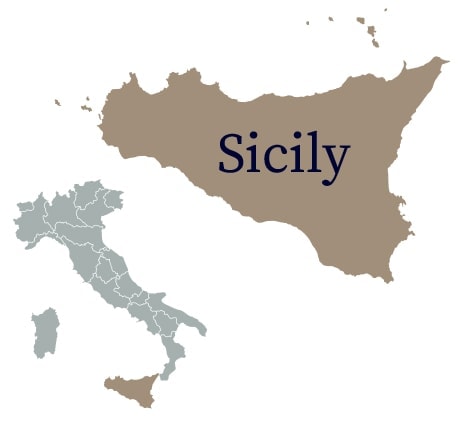
History
Surrounded by the sea, Sicily and its culture have seen their fair share of outside influence over the centuries. Greeks, Spaniards, Arabs and the French are all among those peoples who’ve left a lasting mark on the region’s history, and especially on its cuisine.
Spaniards brought New World goods such as cacao, tomatoes and maize. Greeks came with olive oil, veggies, and Middle Eastern pistachios. Meanwhile, the Arabs introduced fruits such as apricots, citrus and melons; spices of saffron, cinnamon, nutmeg and clove; and sweets including marzipan and even sugarcane. All of these historical culinary influences – from pistachios to produce such as oranges — continue to form a very prominent part of current Sicilian gastronomy.
They’ve worked their way into popular plates such as caponata and pasta alla Norma, both which make use of the beloved regional veggie eggplant, along with other farm-fresh ingredients. Then seafood, of course, is an obvious mainstay in the water-surrounded region, with popular pesce dishes featuring everything from sardines to sea urchin.
Veggies and fish are also combined with Sicily’s own special pastas, including busiate with its spiraled strands, as well as its less-curly cousin casarecce. And no list of Sicilian cuisine would be complete without making mention of arancini, giant fried rice balls often generously packed with cheese, peas, and other goodness depending on the region.
What to drink with all of these diverse local dishes? Why, the local wine, of course. Geographically among the most varied regions in Italy, Sicily has undergone a real revolution in the last quarter century that has made it one of the most important wine production areas in Europe. Though it’s particularly popular for reds such as Cerasuolo di Vittoria, the true ambassador of Sicilian wine is the often full-bodied, earthy and spicy Nero d’Avola.
But It’s around the volcanic Mt. Etna that some of the real wine headlines are made these days. There, ancient grapes lend to whites characterized by a fruity and mineral profile, and reds rich in floral notes, red fruit, and spice, and that are full and dry in the mouth.
Heading west, the Trapani area turns out one of the most famous fortified wines, a relative of Sherry called Marsala — a great wine to finish off a meal, and a great way to toast to Sicily as we get this southern culinary journey started.

History
Surrounded by the sea, Sicily and its culture have seen their fair share of outside influence over the centuries. Greeks, Spaniards, Arabs and the French are all among those peoples who’ve left a lasting mark on the region’s history, and especially on its cuisine.
Spaniards brought New World goods such as cacao, tomatoes and maize. Greeks came with olive oil, veggies, and Middle Eastern pistachios. Meanwhile, the Arabs introduced fruits such as apricots, citrus and melons; spices of saffron, cinnamon, nutmeg and clove; and sweets including marzipan and even sugarcane. All of these historical culinary influences – from pistachios to produce such as oranges — continue to form a very prominent part of current Sicilian gastronomy.
They’ve worked their way into popular plates such as caponata and pasta alla Norma, both which make use of the beloved regional veggie eggplant, along with other farm-fresh ingredients. Then seafood, of course, is an obvious mainstay in the water-surrounded region, with popular pesce dishes featuring everything from sardines to sea urchin.
Veggies and fish are also combined with Sicily’s own special pastas, including busiate with its spiraled strands, as well as its less-curly cousin casarecce. And no list of Sicilian cuisine would be complete without making mention of arancini, giant fried rice balls often generously packed with cheese, peas, and other goodness depending on the region.
What to drink with all of these diverse local dishes? Why, the local wine, of course. Geographically among the most varied regions in Italy, Sicily has undergone a real revolution in the last quarter century that has made it one of the most important wine production areas in Europe. Though it’s particularly popular for reds such as Cerasuolo di Vittoria, the true ambassador of Sicilian wine is the often full-bodied, earthy and spicy Nero d’Avola.
But It’s around the volcanic Mt. Etna that some of the real wine headlines are made these days. There, ancient grapes lend to whites characterized by a fruity and mineral profile, and reds rich in floral notes, red fruit, and spice, and that are full and dry in the mouth.
Heading west, the Trapani area turns out one of the most famous fortified wines, a relative of Sherry called Marsala — a great wine to finish off a meal, and a great way to toast to Sicily as we get this southern culinary journey started.